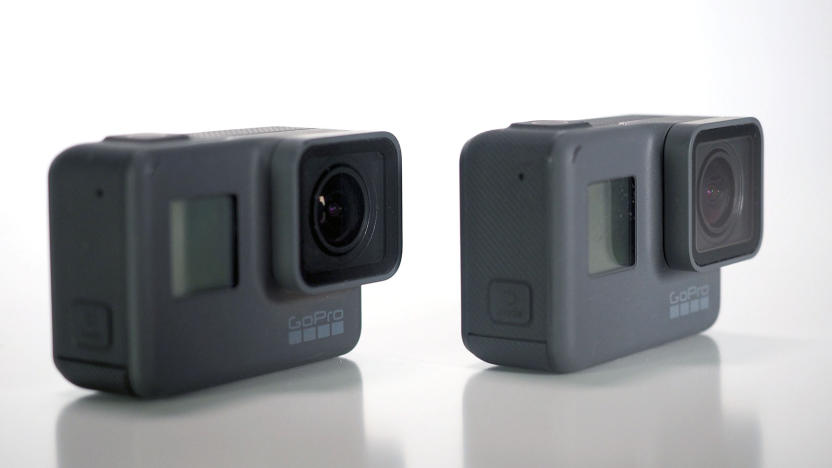gp1
Latest

GoPro Hero 6 review: Slow-mo, stabilization and subtle refinements
If you look at the GoPro Hero 6, it's nearly impossible to tell it apart from the Hero 5, even on close inspection. The older, silver GoPros used to have the model number marked in black text on the front. The only way to tell the most recent cameras apart is small gray-on-gray text on the left side of the camera, and the word "power" on right (replacing "mode"). I even have to hold the camera up to the light to make sure the tiny number 5 isn't a 6 (and vice versa). But use the Hero 6 for more than a few minutes, and the improvements become apparent. There are three standout features that I think make the world of difference between these otherwise-identical GoPros. Here's what they are and why they matter.

The Hero 6 and 'GP1' is GoPro's chance to grow again
"When I first was listening to our team's desire to make a chip, I felt a bit of anxiety, like, are we getting a bit ahead of ourselves? This might be beyond what our capabilities are," Nick Woodman, GoPro founder and CEO, told me in a rare break from his boyish bombast.

GoPro Hero 6: 4K 60 FPS, better stabilization and HDR photos
When GoPro hosts an event in the fall, you get no prizes for guessing what's coming. CEO Nick Woodman just revealed the Hero 6 here in San Francisco, to no one's surprise. What is surprising (if you ignored the leaks) is that the new camera has one big, largely invisible change: the image processor (which GoPro is calling the GP1). We'll get to why that's important in a bit.

BenQ GP1 LED pocket projector reviewed: loved, possibly lurved
The universal acclaim for BenQ's GP1 LED projector is deafening. Naturally, some trade-offs were made in brightness, contrast, and resolution in order to squeeze things down to a palm-sized 5.4 x 4.7 x 2.1-inch footprint. But at just 1.4-pounds, it won't cause your bicep, atrophied by pantywaist netbooks, too much strain. Thanks to a LED light source with a 20,000 hour lifespan, this $499 DLP projector manages to spread 100 lumens across 858 x 600 pixels with a 2,000:1 contrast -- specs that give solid results when projecting a 40-inch image in a bright, shades-drawn room on up to 80-inches in near-black environments. Better yet, pop in a USB stick loaded with images (JPEG, GIF, BMP, TIFF) or videos (MPEG4, MJPEG, xvid, 3ivX) and the projector will automatically launch a media playback menu -- no laptop required. The lack of zoom, an ailment common in all these tiny projectors, will limit placement and a measured 38dB (from a distance of 30cm) operational hum will be distracting to home theater buffs or cubical monkeys forced into the sleepy corporate dens of PowerPoint. But all-in-all, BenQ's come up with a winner, and truth doesn't make a noise.Read -- TrustedReviews Read -- TrustedReviews (video)Read -- SlashGear Read -- iLounge

BenQ's $499 Joybee GP1 pocket projector up for pre-order
We had the pleasure of checking out BenQ's Joybee GP1 pocket projector back in March at CeBIT, and now the bantam beamer is just about ready to ship here in the States. Starting now (like, right now), interested consumers can plop down $499 in order to secure a place in line, ensuring that you'll be one of the first on the block to take possession of the planet's first LED-based PJ with a USB reader. Specs wise, you'll find a DLP projection system kicking out an 858 x 600 resolution, 100 ANSI lumens, a 2,000:1 contrast ratio, a built-in 2-watt speaker and VGA / component / composite inputs. Five bills sounds a little steep for what it is, but hey, it's a 1.4 pound projector -- did you really expect it to be economical?

BenQ GP1 (P1) LED pocket projector eyes-on
Remember that GP1 pico projector that was quietly announced alongside a slew of others at CES this year? Apparently it's sporting the P1 moniker in Europe, which is infinitely confusing given that BenQ used to have a PJ that looked mighty similar to this one, and yeah, it too was called the P1. At any rate, the GP1 you see here is BenQ's first ever LED beamer, and with it will come an 858 x 600 native resolution, 100 ANSI lumens, 2,000:1 contrast ratio, an integrated USB reader, TI's DLP technology and a lamp life of 20,000 hours. It should be out in Germany by April, but we're still expecting it here in the US next month for a lofty $599.%Gallery-46757%

TI's DLP Pico technology unveiled in new round of pico projectors
At last year's CES, Texas Instruments was simply demonstrating prototypes of its DLP Pico technology; this year, it's officially showcasing the real deal. The aforesaid chipset is currently residing within the WowWee Cinemin line and Optoma's PK-101, but here's something you didn't know. Evidently, the chip will also be a critical part of pico projectors from Samsung (the MBP200 with an SD card slot), BenQ (the GP1 with an integrated USB port; available in March for $599) and Toshiba (TDP-F10U Mobile LED Projector). Also of note, BUG Labs will presumably be introducing a module of its own dubbed BUGprojector, which will enable legible beaming of 480 x 320 images at just eight inches away along with stereo playback and a brightness of 9 lumens. Lastly, TI itself has announced that a DLP Pico Projector Kit which sports an HVGA resolution, a universal power supply and a few other integral components necessary for integrating it into consumer, industrial and medical products.Read - TI's DLP Pico roundupRead - TI DLP Pico Projector Kit

